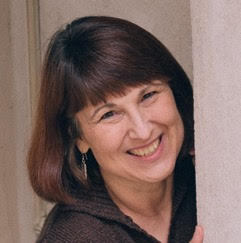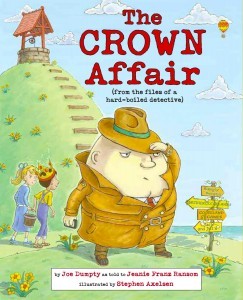Jeanie Franz Ransom's Blog, page 2
December 2, 2015
Thanks for Helping Get This Party Started
More than 400 book launch parties got underway yesterday on the Society of Children’s Book Writers and Illustrators website. That’s a lot of parties! Which is why I’m very grateful that people took the time to stop by my book launch party for the Crown Affair. There’s still time to attend, because this party’s an Open House. There’s even a drawing for a door prize. All you have to do is show up and sign up!
December 1, 2015
It’s Party Time! Drop in and Enter to Win!
Detective Joe Dumpty’s celebrating the launch of his second book, THE CROWN AFFAIR, over at Party Central. Joe’s a generous guy, so he’s giving away a signed set of his “case files.” The party’s started, the contest is ready to enter, and you’re invited! 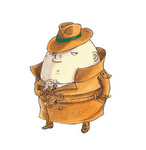
November 30, 2015
Party Hop and Shop at the First SCBWI Book Launch!
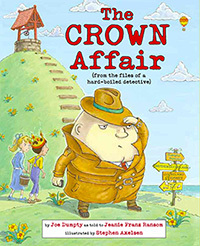 Thousands of children’s books are published annually, so it’s understandable if you miss a few every year. But don’t you wonder if you missed out on something that was right up your reading alley? I hate when that happens!
Thousands of children’s books are published annually, so it’s understandable if you miss a few every year. But don’t you wonder if you missed out on something that was right up your reading alley? I hate when that happens!
Never fear! The Society of Children’s Book Writers and Illustrators’ Book Launch Party is here, just in time for holiday shopping. Starting at midnight tonight EST, authors and illustrators who’ve had books published in the past year will be throwing parties online, and you’re invited!
I’ll be doing a Book Launch Party for “The Crown Affair,” the second picture-book mystery from the files of hard-boiled detective Joe Dumpty. Come as you are, enter to win a signed set of Joe Dumpty books, and don’t forget to sign my guest book! I’ll post an update once the link goes live, but for now, it’s http://www.scbwi.org. Happy party hopping and shopping!
November 26, 2015
TBT 2008: Yes, Book Signings Can Be Awkward. But They Can Be Awesome, Too!
Since my first children’s book came out fifteen years ago, a lot has changed. But book signings continue to elicit a level of anxiety and insecurity not felt since middle school. Here’s why they’re still worth doing.
Tale of a Book Signing
I’m sitting at a table at a local bookstore, signing copies of my latest book. That is, I would be signing copies, if anyone was buying the book. But it’s a sunny Saturday afternoon in late September. Who goes to a bookstore on a day like that? Not unless they’re on a mission to buy a particular something – and chances are, it’s not my book. After all, it’s not like I’m a famous author, or even a semi-famous author. No one was standing in line outside the store, awaiting my arrival. There wasn’t a line inside the store, either. Maybe someday. But probably not. In my experience as the author of five children’s books, you usually don’t sell a lot of books at a signing – unless maybe it’s your first signing and you have lots of friends and family, or you’re a well-known author or celebrity.
Since my first book came out in 2000, I’ve done a variety of book signings – including what I call “solo signings” where I was the only author featured, local author showcases where I joined at least two other writers at a bookstore or library to sign our books, and signings at conferences where I was one of many authors featured at various booths in an exhibit hall. I’ve had signings where I’ve sold just one or two copies of my book. Twice, I sold every copy the store had in stock. And then there was the signing that cost me more than $200, because I got a speeding ticket on the way to the bookstore. P.S. I didn’t sell a single book that day.
So, why even bother doing signings if you don’t sell lots of books? First of all, books don’t sell books. People sell books. Book signings are about building relationships, starting with the store community relations manager, or CRM, and the store staff. These are the people who can recommend your book to customers, so you want to be very nice to them. The booksellers I’ve worked with over the past eight years are happy to have me back in their stores. They welcome authors who are professional and pleasant to work with. According to several booksellers I’ve worked with, many authors – some of them even children’s authors are demanding and downright rude. Just like ungrateful houseguests, they probably won’t be invited back.
Second, you do signings to connect with customers. Although they may not buy your book that day, they might come back another time, or tell a friend about it. And for those who do buy your book, it’s wonderful to know who your “baby” is going home with.
Third, you do signings to build name recognition. Book signings are just a small part of a comprehensive marketing plan, but they’re important. Anytime you get your name out there, anywhere, there’s a chance someone will be interested in buying your book, scheduling you for a school visit, or booking you to speak at a conference. As you write more books, you’ll probably do more signings, and before you know it, your career will have taken off. As I look at it, just get your name out there enough and sooner or later, something’s bound to stick.
Here are a few things I’ve learned during my various book signings:
—Arrive early. Give yourself enough time to find the bookstore, introduce yourself, and get set up. Most places will provide you with a table, and yes, a chair, plus copies of your books, and some sort of signage that says who you are.
—Bring a few of your favorite things to “spiff up” your signing area, but don’t go overboard. You probably won’t have the luxury of a lot of room, so limit yourself to a couple of simple accents that work with the theme and/or look of your book.
—Pack a couple of your favorite pens, Sharpies, or whatever you like to use for signing books. Most places will supply you with something to write with, but if you prefer a particular type of writing instrument, you may want to bring it along. It’s also useful to have a pad of Post-It notes or some type of paper for making sure you have the correct spelling of any names used in your dedications..
—Bring candy if you like, but make sure it’s the kind that melts in your mouth, not in your hands. You don’t want any sticky paws on the pages of your book, especially if those paws belong to someone who hasn’t yet purchased the book. Avoid anything with nuts, for allergy reasons. And if you eat when you’re nervous or bored, don’t bring your favorite treats. You could easily be both, all in a single signing.
—-Offer a way for customers to find out more about you and your books. Do you have another title coming out? Do you visit schools? Do you have a web site? Send customers home with a flyer, business card, or personalized bookmark with your contact information.
—Smile at everyone you make eye contact with. Greet everyone that passes your table. Invite people to look at your book by handing it to them directly. This instantly connects you to the customer, and connects the customer to your book. It’s called “hand selling,” and it’s what booksellers do when they recommend a favorite book to a customer. They do it because it works. It can work for you, too.
— –Offer to stay late. You never know who you’ll meet if you hang around a few extra minutes, or longer. And it’s an excuse to spend more time at just about every writer’s favorite place: a bookstore! Ask if you can sign any remaining copies. An “autographed copy” sticker on the front cover of your book can attract customers long after you’ve left the bookstore.
Remember, books don’t sell books. People sell books. If you’re a published author, you’ve already done the hardest part — convincing a publisher to buy your book. After that, you can do anything!
TBT 2008: Tale of a Book Signing
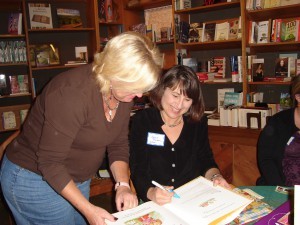 I am sitting at a table at a local bookstore, signing copies of my latest book. That is, I would be signing copies, if anyone was buying the book. But it’s a sunny Saturday afternoon in late September. Who goes to a bookstore on a day like that? Not unless they’re on a mission to buy a particular something – and chances are, it’s not my book. After all, it’s not like I’m a famous author, or even a semi-famous author. No one was standing in line outside the store, awaiting my arrival. There wasn’t a line inside the store, either. Maybe someday. But probably not. In my experience as the author of five children’s books, you usually don’t sell a lot of books at a signing – unless maybe it’s your first signing and you have lots of friends and family, or you’re a well-known author or celebrity.
I am sitting at a table at a local bookstore, signing copies of my latest book. That is, I would be signing copies, if anyone was buying the book. But it’s a sunny Saturday afternoon in late September. Who goes to a bookstore on a day like that? Not unless they’re on a mission to buy a particular something – and chances are, it’s not my book. After all, it’s not like I’m a famous author, or even a semi-famous author. No one was standing in line outside the store, awaiting my arrival. There wasn’t a line inside the store, either. Maybe someday. But probably not. In my experience as the author of five children’s books, you usually don’t sell a lot of books at a signing – unless maybe it’s your first signing and you have lots of friends and family, or you’re a well-known author or celebrity.
Since my first book came out in 2000, I’ve done a variety of book signings – including what I call “solo signings” where I was the only author featured, local author showcases where I joined at least two other writers at a bookstore or library to sign our books, and signings at conferences where I was one of many authors featured at various booths in an exhibit hall. I’ve had signings where I’ve sold just one or two copies of my book. Twice, I sold every copy the store had in stock. And then there was the signing that cost me more than $200, because I got a speeding ticket on the way to the bookstore. P.S. I didn’t sell a single book that day.
So, why even bother doing signings if you don’t sell lots of books? First of all, books don’t sell books. People sell books. Book signings are about building relationships, starting with the store community relations manager, or CRM, and the store staff. These are the people who can recommend your book to customers, so you want to be very nice to them. The booksellers I’ve worked with over the past eight years are happy to have me back in their stores. They welcome authors who are professional and pleasant to work with. According to several booksellers I’ve worked with, many authors – some of them even children’s authors are demanding and downright rude. Just like ungrateful houseguests, they probably won’t be invited back.
Second, you do signings to connect with customers. Although they may not buy your book that day, they might come back another time, or tell a friend about it. And for those who do buy your book, it’s wonderful to know who your “baby” is going home with.
Third, you do signings to build name recognition. Book signings are just a small part of a comprehensive marketing plan, but they’re important. Anytime you get your name out there, anywhere, there’s a chance someone will be interested in buying your book, scheduling you for a school visit, or booking you to speak at a conference. As you write more books, you’ll probably do more signings, and before you know it, your career will have taken off. As I look at it, just get your name out there enough and sooner or later, something’s bound to stick.
Here are a few things I’ve learned during my various book signings:
—Arrive early. Give yourself enough time to find the bookstore, introduce yourself, and get set up. Most places will provide you with a table, and yes, a chair, plus copies of your books, and some sort of signage that says who you are.
—Bring a few of your favorite things to “spiff up” your signing area, but don’t go overboard. You probably won’t have the luxury of a lot of room, so limit yourself to a couple of simple accents that work with the theme and/or look of your book.
—Pack a couple of your favorite pens, Sharpies, or whatever you like to use for signing books. Most places will supply you with something to write with, but if you prefer a particular type of writing instrument, you may want to bring it along. It’s also useful to have a pad of Post-It notes or some type of paper for making sure you have the correct spelling of any names used in your dedications..
—Bring candy if you like, but make sure it’s the kind that melts in your mouth, not in your hands. You don’t want any sticky paws on the pages of your book, especially if those paws belong to someone who hasn’t yet purchased the book. Avoid anything with nuts, for allergy reasons. And if you eat when you’re nervous or bored, don’t bring your favorite treats. You could easily be both, all in a single signing.
—-Offer a way for customers to find out more about you and your books. Do you have another title coming out? Do you visit schools? Do you have a web site? Send customers home with a flyer, business card, or personalized bookmark with your contact information.
—Smile at everyone you make eye contact with. Greet everyone that passes your table. Invite people to look at your book by handing it to them directly. This instantly connects you to the customer, and connects the customer to your book. It’s called “hand selling,” and it’s what booksellers do when they recommend a favorite book to a customer. They do it because it works. It can work for you, too.
— –Offer to stay late. You never know who you’ll meet if you hang around a few extra minutes, or longer. And it’s an excuse to spend more time at just about every writer’s favorite place: a bookstore! Ask if you can sign any remaining copies. An “autographed copy” sticker on the front cover of your book can attract customers long after you’ve left the bookstore.
Remember, books don’t sell books. People sell books. If you’re a published author, you’ve already done the hardest part — convincing a publisher to buy your book. After that, you can do anything!
November 19, 2015
Another Post from the Past
It’s “Throw Back Thursday,” and this week’s post is about the benefits of going beyond the ordinary — whether it’s looking for a pumpkin or an idea.
Thinking Beyond Orange
by JEANIERANSOM on OCTOBER 6, 2012
Every year about this time, my family goes in search of some pumpkins for our front porch. There are five people in our family, so we have to have at least five pumpkins. Somehow we always end up with more!
We usually go to the same farm to pick pumpkins right out of the field. But last October, I decided we’d try a different place – a small, family-owned farm that just so happened to be right around the corner from the big, commercial place we traditionally go. And there we discovered a surprising fact: pumpkins aren’t always orange!
I don’t know about you, but whenever I think of pumpkins, I think orange. So when the farmer took us into his field to look for pumpkins, I was expecting to see lots of orange. I did see orange, but I also saw white, yellow, and blue. Blue pumpkins? Who knew?
The farmer walked us through the field, pointing out the different varieties: Cinderella pumpkins, warty pumpkins, cheese pumpkins, ghost pumpkins, and many more. As you can see from the picture, we found it hard to resist bringing home a few extra pumpkins!
 Going the extra mile, literally, to find a new spot to pumpkin pick is much like working a little harder to find a fresh slant on a topic you’re writing about. It takes time to go beyond the obvious when you’re assigned to do a story on a popular subject like, say, Abraham Lincoln. But if you’re willing to search a bit more, chances are you’ll find some quirky, little-known fact that will make the difference between an ordinary story and an extraordinary one.
Going the extra mile, literally, to find a new spot to pumpkin pick is much like working a little harder to find a fresh slant on a topic you’re writing about. It takes time to go beyond the obvious when you’re assigned to do a story on a popular subject like, say, Abraham Lincoln. But if you’re willing to search a bit more, chances are you’ll find some quirky, little-known fact that will make the difference between an ordinary story and an extraordinary one.
Ordinary stories, much like orange pumpkins, are easy to find. Are you ready to mix it up a bit? Go find a pumpkin that’s different. Put it where you can see it when you write. Once you go beyond orange, a whole new world of possibilities awaits you.
November 10, 2015
I love February!
February is for conversation hearts, flowers, and chocolate. It’s also just happens to be the month I’ve had a new book published on the 15th — two years in a row. February 2015 was THE CROWN AFFAIR; February 2016 is RED AND THE LITTLE BITTY WOLF, available to pre-order from Amazon and other online booksellers, as well as at your local bookstore. I think February might be my favorite month — new books and chocolate, too? What’s not to love?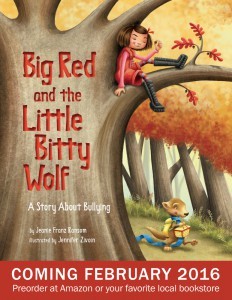
November 5, 2015
Where Do Writers Get Their Ideas?
It’s “Throw Back Thursday,” and from now until the end of the year, I’m going to post a writing-related “relic” each week. It’ll be a mix of topics, so whether you’re a reader, a writer, or an educator, you should find something that’s relevant — and hopefully, interesting.
This one’s for teachers, librarians, and anyone who’s just plain curious! (Note: the photo is definitely TBT!) charlesbridge.blogspot.com/search?q=Jeanie+Ransom
November 1, 2015
Join Me for “WriToThEndMo”
 It’s November 1st. Time to write a 50,000 novel in thirty days (“NaNoWriMo”), brainstorm thirty picture-book ideas in a month (“PiBoldMo”) or both. (Yes, both. Apparently it does happen.)
It’s November 1st. Time to write a 50,000 novel in thirty days (“NaNoWriMo”), brainstorm thirty picture-book ideas in a month (“PiBoldMo”) or both. (Yes, both. Apparently it does happen.)
But I don’t need to start a new novel when I have 25,000 words of a MG novel written. And I don’t need any more picture-book ideas right now, either. What I really need to do is finish some projects I’ve already started.
So I’m making this November “WriToThEndMo.” I’ll write to the end of the month, and write to “The End” of as many manuscripts as I can in thirty days. How about you? I’d love to know what you’d like to finish this month. And no, holiday shopping doesn’t count!
July 6, 2015
Questions Answered. Info Offered.
It’s July, and I’m officially the Featured Author of the Month for the Missouri Society of Children’s Writers & Illustrators (SCBWI). In my interview with fellow author and Missouri-SCBWI member Peggy Archer, I talk about everything from writer’s block to agents, with a hummingbird somewhere in the middle!
Featured Author of the Month
PAL Author for the month of July 2015
Jeanie Franz Ransom
Missouri SCBWI welcomes Jeanie Franz Ransom, from O’Fallon, Missouri, as our July PAL Author of the Month. Jeanie sold her first story to Seventeenmagazine when she was a teen, and has been writing ever since. She is an award-winning author of children’s picture books, and her books have received starred reviews from Booklist and Publishers Weekly. She is also a former elementary school counselor.
I’m so happy to welcome you here today, Jeanie, and I thank you for sharing some of your writing life with our readers. Until now, your writing has been mainly picture books. Do you have an agent?
I do. I’d sold my first six books on my own, and I wasn’t sure if I needed an agent. But then someone told me that when the business of writing gets in the way of writing, it’s time to find an agent. I knew I was getting to that point, but it wasn’t until Lori Kilkelly from Rodeen Literary Management spoke at one of the MO-SCBWI Fall Conferences that I actually got serious about it. I sent Lori a query, and three months later, I signed with Rodeen Literary Management. Lori takes care of submitting manuscripts, negotiating contracts, and so much more. She sold three books for me in three months, and the advances were like night and day compared to what I got on my own. I never knew how much I needed an agent until I got an agent. And it’s all thanks to attending a MO-SCBWI conference!
Do you ever experience writer’s block?
I think that everyone experiences writer’s block at one time or another. If you haven’t, I want to know your secret! I’ve had an ongoing battle with a block for years, but I’ve managed to chisel it down far enough to produce three new books.
What books are you reading now?
I just finished working my way through a pile of advance copies from ALA Midwinter this past January. Two of the best new middle-grade novels I read were Good-bye Stranger by Rebecca Stead and Alice Hoffman’s Nightbird. Now I’m ready to dive into Judy Blume’s new novel for adults!
What encouragement helped you along your way?
My third-grade teacher was the first person to encourage me to write, and I’m forever grateful to her. I’ve had some wonderful mentors, bosses, co-workers, and editors over the years. But when I started writing for children, I found out that children’s writers are some of the nicest people in the world. The encouragement I’ve gotten — and continue to get —keeps me writing. The members of my critique group are some of my biggest cheerleaders, second only to my family!
Is there anything that you find particularly challenging in your writing?
I tend to be a bit of a hummingbird, flitting from idea to idea rather than just picking one and sticking with it from start to finish. My new writing mantra is “Focus and finish!”
When I have a lot to get done and really need to concentrate, I work at the desk I set up in my oldest son’s room after he moved to New York two years ago. My son teases that I’m more successful now because I use his room as my office! I also like to write on my front porch, weather permitting, or at a coffee house. I wish I could say that I write every day, but I don’t. I also don’t exercise every day. I do eat chocolate daily, though. Does that count for something?
I like the ‘daily chocolate’ idea, Jeanie! What is the best piece of advice you’ve ever been given about writing?
BIC — Butt in Chair!
What projects are you working on now?
I’m working on a couple of new picture books, including one with fellow SCBWI member and critique buddy, Stephanie Bearce. I’ve also started a middle-grade novel, which is exciting as well as terrifying. Exciting, because it’s a totally new genre for me. Terrifying, because I’ve never written a book that’s more than 1200 words. Fortunately, I have writing friends who have completed at least one MG novel, so I have people to turn to if I get stuck.
Do you have any new books coming out?
I have three new picture books coming out in the next two years: Cowboy Car (Two Lions), Big Red and the Little Bitty Wolf: A Story About Bullying (Magination Press), and There’s a Cat in Our Class! (also Magination Press).
Do you have any advice for beginning children’s writers?
Join SCBWI, attend conferences and workshops, and start building connections. It may seem a little scary, but there’s really no better way to meet editors, agents, and other writers. There are lots of resources available for children’s writers who are just getting started — including the SCBWI website! Be a sponge and soak up as much as you can. Join a critique group! You’ll get feedback and support from fellow children’s writers, and you’ll probably end up with some new friends!
Thank you so much for visiting with us here, Jeanie.
You can find out more about Jeanie and her books on her website (www.jeanieransom.com), or join her on her facebook page (www.facebook.com/JeanieRansomAuthor).

